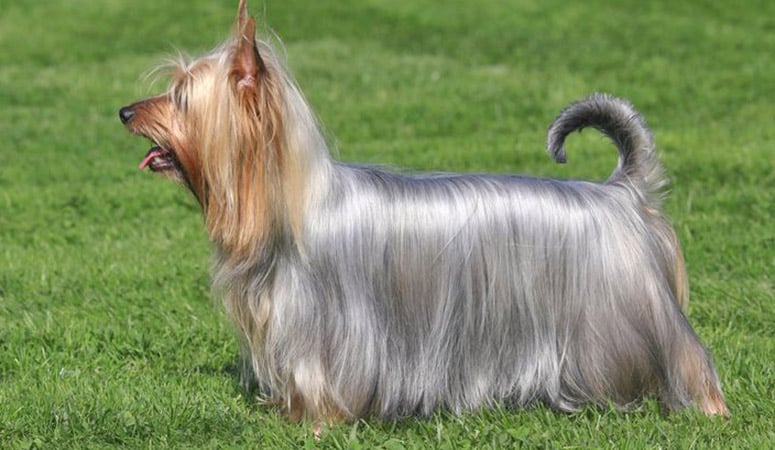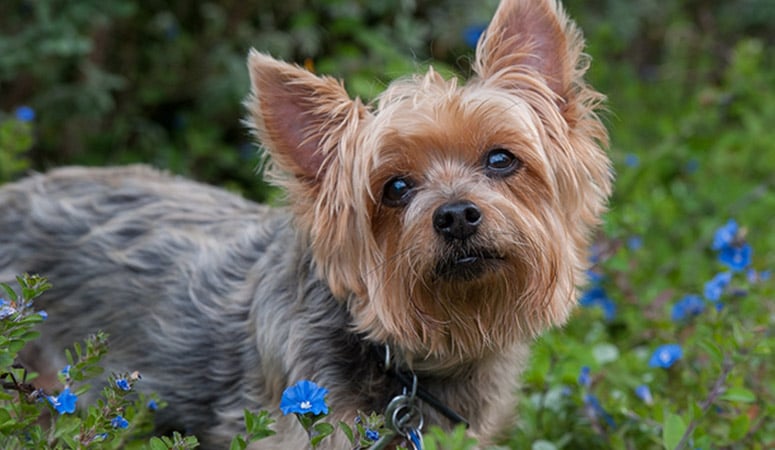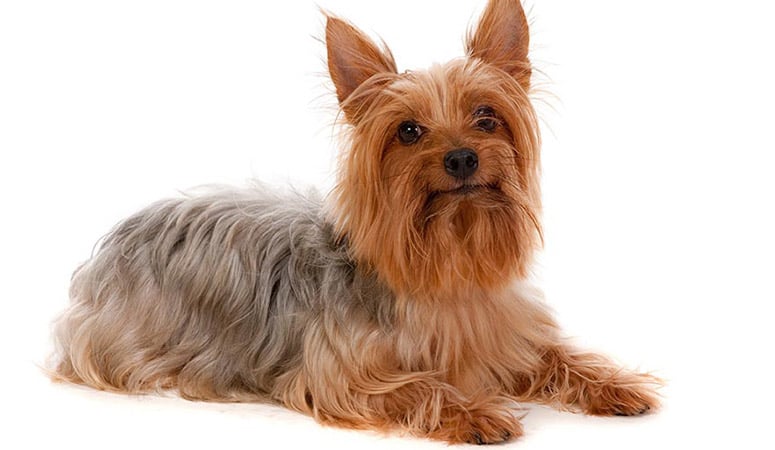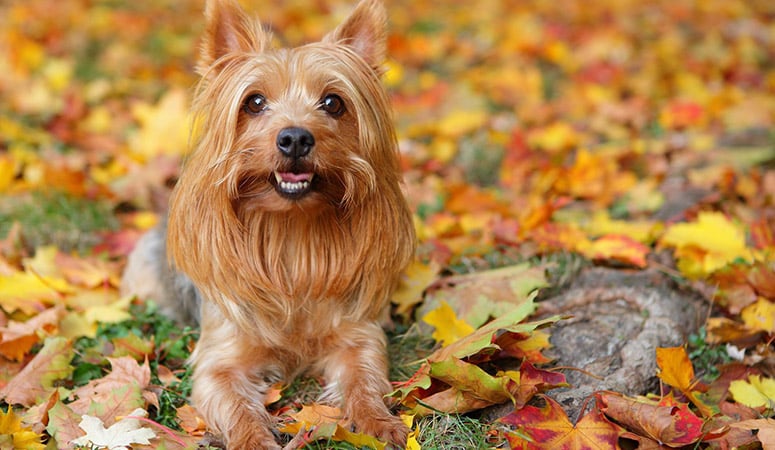Silky Terrier

Known as the Australian Silky Terrier in its country of origin, the Silky Terrier is a small breed of dog of the terrier dog type, and the breed is called the Silky Terrier in North America. They have silky and glossy coat that is straight and single, following the body outline rather than falling to the floor.
| Other Names | Australian Silky Terrier, Silky Toy Terrier, Sydney Silky |
| Color | Black, Black and Tan, Blue, Gray, Silver, Tricolor |
| Height | Males: 9-10 inches. Females: 8-10 inches. |
| Weight | Males: 8-10 pounds. Females: 8-10 pounds. |
| Life Span | 13-15 years |
| Personality | Friendly, Quick, Keenly Alert |
| Exercise | Regular Exercise |
| Origin |
| Popularity | #109 |
| Groom Needs | 2-3 Times a Week |
| Kids Friendly | Yes with supervision |
| Dog Friendly | Yes with supervision |
| Watch Dog | |
| Family Dog | |
| Litter Size | 3-5 |
Silky Terrier Pictures
Silky Terrier Video
Introduction
That’s why they are called Silky Terriers because that’s exactly what they are, silky, soft, and super affectionate and alert. And very cute too, only around 10 inches at the shoulders and weighing in at about 11 pounds. They have little feet that look similar to a cat. Their silky long hair kind of parts in the middle of their backs in gorgeous colors; black to blue to cream, to fawn, to grey, and silverfish – it needs brushing every day and trimming regularly as well so it doesn’t grow to the ground and get in his way, or get in their eyes, for example. He hates being left alone and it is such an anxious time for him that he will even have urination accidents. This little dog needs company all the time, so don’t get one if you are not prepared for that. He has lots of energy and stamina and needs attention with his owner – he loves fun and games outside, and daily walks are all important to him. A Silky Terrier actually prefers the company of adult humans to young children and even other pets. He can get quite abrasive with other dogs too, and if in a fight with a bigger dog, he does not back down easily.
Living with Silky Terrier
The Silky Terrier has a long coat that needs to be combed two or three times a week to prevent matting and tangles. A long-toothed metal dog comb can also come in handy for gently working through areas where tangles may be beginning to form. Usually, a bath every four to six a week with a gentle and dog-friendly shampoo is helpful to keep the dog’s coat and skin clean and healthy.
Also, the owner needs to check and clean the dog’s ears every week for the signs of infection, or wax buildup. And brush your dog’s teeth several times a week to remove tartar buildup and the bacteria that lurk inside it. Daily brushing is better to keep fresh breath and prevent gum disease. Besides, trim the nails every month if the dog doesn’t wear the toenails down naturally.
The Silky Terrier is a real dog who needs exercise and training although he may look like a toy. A healthy Silky Terrier requires an hour or two of physical activity each day to remain fit. There are some good exercise options for Silky Terrier, such as daily walks, romping with their owners in the yard, or trips to a dog park with a special area for small breeds. With enough exercise, the Silky Terrier could live comfortably in an apartment or condo. Besides, Silky Terriers excel at a variety of dog sports, including flyball, agility training, and Earthdog tests as they are agile and athletic.
Generally, it is recommended to feed a Silky Terrier with a half cup to one cup of high-quality dry dog food every day, divided into two meals. And there should be clean and fresh water at all times. More importantly, the food amount should depend on the dog’s weight, size, age, and activity level.
Some dogs are easy to get overweight, so you need to watch their calorie consumption and weight level all the time. Treats may be an important aid in training, but excessive intake can lead to obesity. Also, owners need to distinguish which human food is safe for dogs and which are not. If you have any problems with your dog’s weight or diet, just consult from your veterinarian.
Silky Terriers are prone to the following health conditions: epilepsy, patellar luxation, tracheal collapse, Cushing’s disease, Legg-Calve-Perthes disease, diabetes, allergies, intervertebral disk disease, short hair syndrome of Silky breeds, cataracts, cystine urolithiasis, etc.
Major concerns: none
Minor concerns: Legg–Perthes, patellar luxation
Occasionally seen: epilepsy, diabetes, allergies, tracheal collapse, Cushing’s disease
Suggested tests: knee, eye
Total Annual Cost: $2450
Cost is estimated for the first year and may vary depending on many factors, such as dog food, health care, leash, collar, licensing, possible fencing, crates, training and obedience classes, dog-walking, grooming, treats, toys, flea, tick, and heart-worm meds, microchips, etc.
Silky Terriers are intelligent and eager to please, they can learn basic commands with ease, and they can do better if the training is consistent from an early age. It is recommended to start early socialization and puppy training because Silky Terriers tend to become more set in its ways as time goes on. The dog’s natural stubbornness will be become apparent if this happens and changing any problematic behaviors at this time will be difficult.
And Silky Terriers enjoy agility training, dog sports, and advanced obedience classes. They also like spending time with their owners, while staying mentally and physically active.
History
No one really knows the exact origin of the Silky Terrier, but most agree the breed originated in Australia in the latter part of the 19th century.
They are a mix of the small, yet sturdy, rough-coated Australian Terrier and the Yorkshire Terrier.
Although they were developed mainly as pets and companions, they also proved their worth as ratters and snake hunters.
Fans introduced the first Silky Terriers to America in the 1930s, and servicemen stationed in Australia in World War II also brought these furry companions back to the United States. They got widespread attention and interest in 1954 when a photographer at a dog show saw Redway Blue Boy, a Silky Terrier puppy. The photographer asked the owner to bring Redway Blue Boy to the studio where he appeared on the cover of This Week magazine, stealing America’s heart and making them very popular.
In March 1955, the first meeting of the “Sydney Silky Terrier Club of America” was held in California, but later, the name changed to the “Silky Terrier Club of America”. This conformed to the American Kennel Club’s name for the breed.
On May 1, 1959, Silkys’ were accepted as AKC’s 113th breed and the silky terrier was officially recognized by the American Kennel Club (AKC) in 1959.
Helpful Information
Breed Club: SILKY TERRIER CLUB OF AMERICA, INC.
Breed Club Link: http://silkyterrierclubofamerica.org/
Breed Club Rescue: Silky Terrier Rescue Charitable Trust
Breed Club Rescue Link: http://silkyrescue.tripod.com/index.htm




